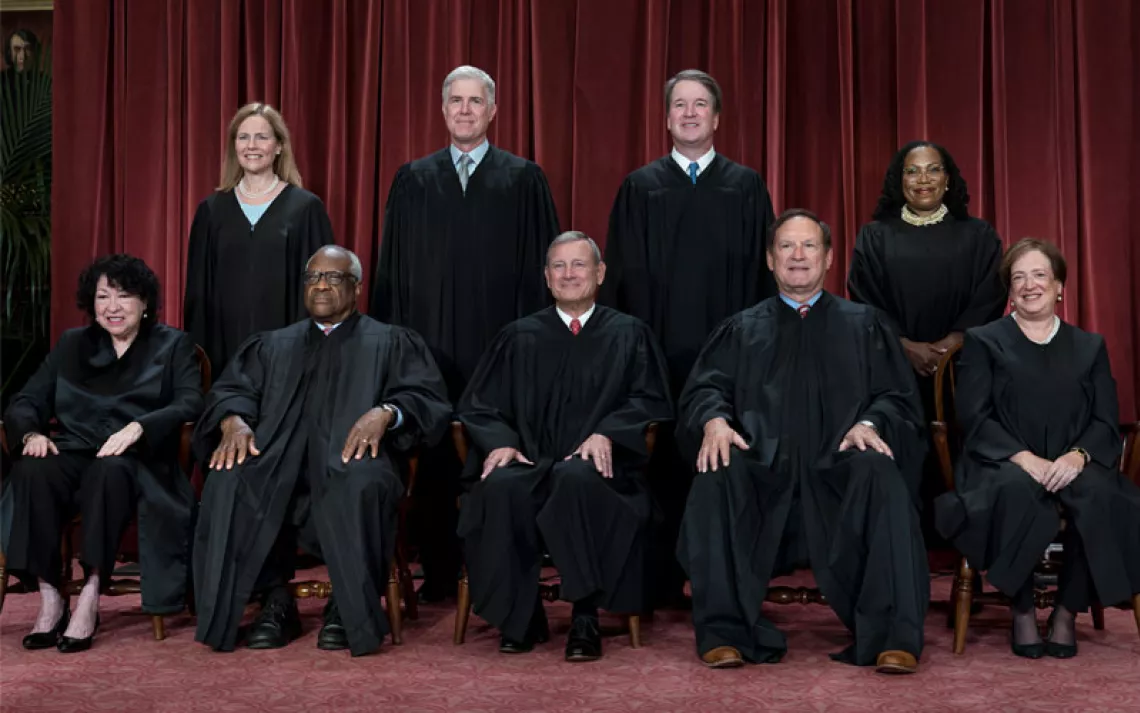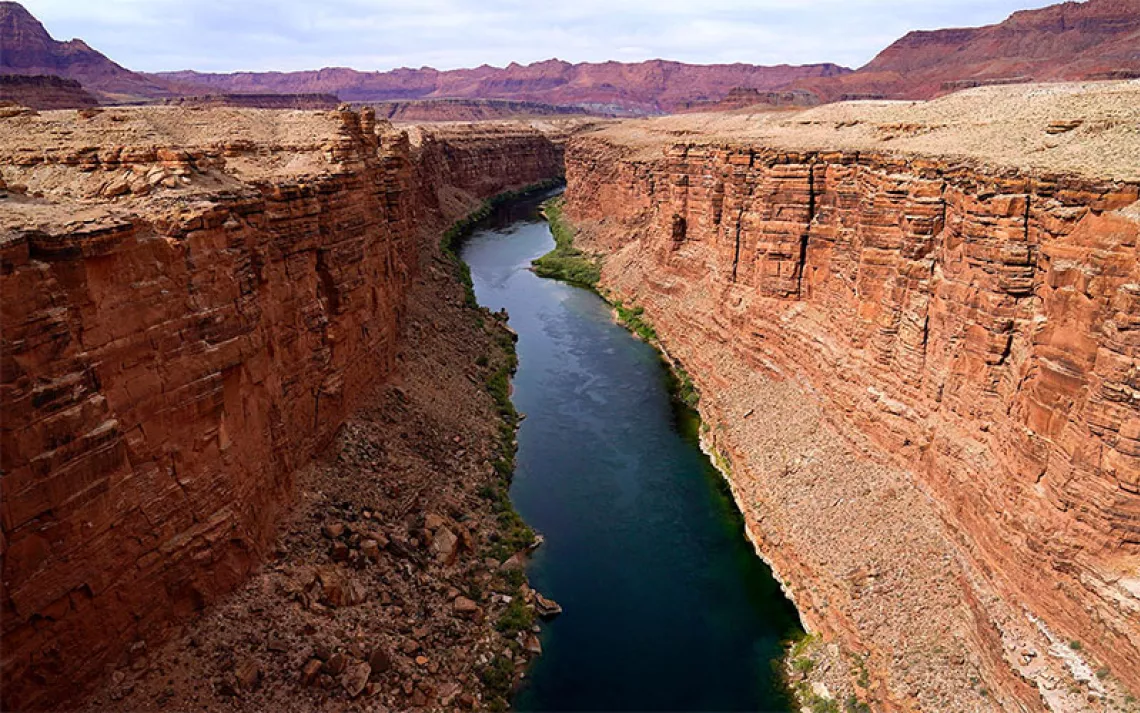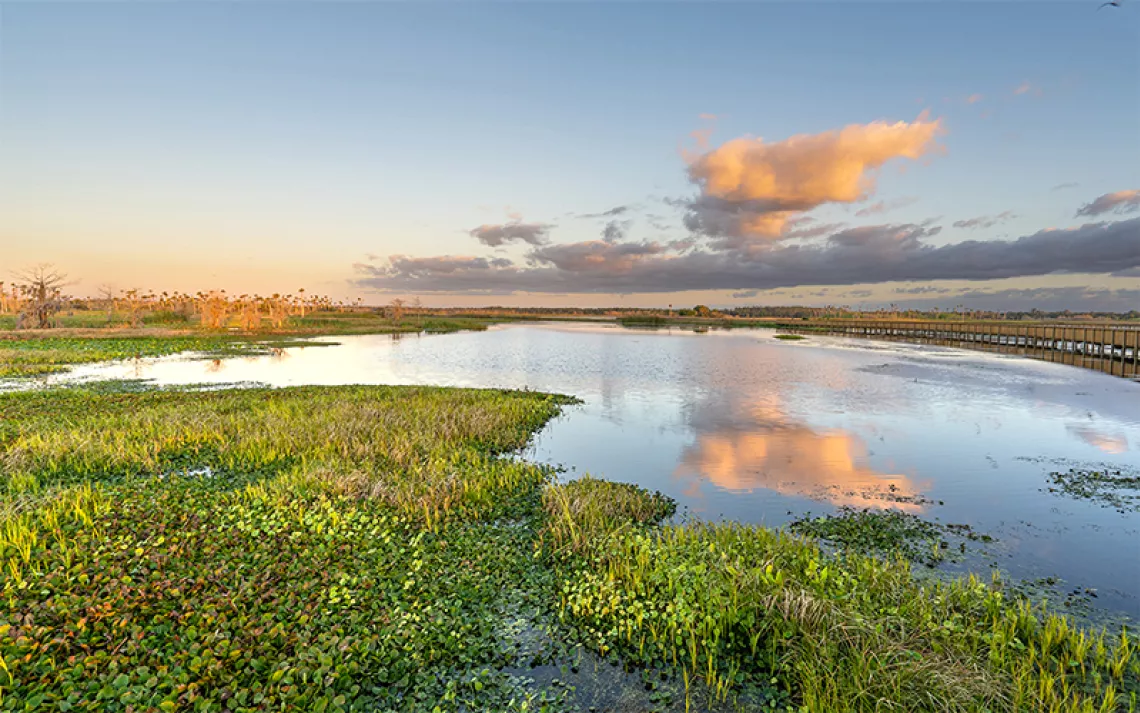Supreme Court Opens Its New Term With a Major Clean Water Case
During oral arguments, many justices appear skeptical of excluding most wetlands from Clean Water Act protection

Clean water advocates rally outside the Supreme Court on Monday, including the Sierra Club’s own Leslie Fields (second from right). | Photo by Francis Chung/E&E News/POLITICO via AP Images
Sometimes fishing expeditions go awry.
For nearly 15 years, some of the country’s biggest polluters and extractive industries have sought to attack the Clean Water Act—the 50-year-old law that safeguards the integrity of the country’s waters—via a lawsuit called Sackett v. EPA. As the Supreme Court’s new session opened on Monday morning, environmental law experts feared that industry might finally succeed, and that the conservative-dominated court would take the Sacketts up on their invitation to water down the Clean Water Act. “Nothing good can come of this,” Dave Owen, a professor at UC Hastings School of Law, told Sierra before the court heard the case.
But oral arguments at the court’s first case of this term showed a number of justices—including some conservative ones—who appeared unwilling to radically rewrite the Clean Water Act. The Sacketts and their corporate allies may find that sometimes you can go fishing and come up with nothing.
When is a body of water not really a body of water? What, exactly, is the meaning of the word adjacent? Those seemingly arcane semantic questions dominated the arguments in Sackett v. EPA, a case filed by an Idaho couple who run a commercial construction and excavation business against an EPA decision that they needed a federal permit to build a home on a marshy area not far from Idaho’s Priest Lake. The plaintiffs’ law firm, the conservative Pacific Legal Foundation, has sought to portray the couple as an ordinary family just looking to construct a house for themselves who were stymied by federal regulations after they dumped fill into a wetland. “It’s now going on 16 years since petitioners Mike and Chantell Sackett began construction of a house on a vacant lot in a largely built-out subdivision, yet their plans remain on hold to this day,” the couple’s attorney, Damien Schiff, stated at the outset of Monday’s hearing.
The case, like nearly all that come before the Supreme Court, is likely to establish a precedent that stretches far beyond the particulars of this dispute. The Sacketts’ case has become a stalking horse for a larger campaign by some of the country’s largest industries to chop away at the scope of the Clean Water Act. Those filing briefs supporting the Sacketts included the American Petroleum Institute, the American Exploration and Mining Association, the National Homebuilders Association, and mining giant Freeport-McMoRan. At issue is whether the law will continue to cover 50 million acres of wetlands, fens, and marshes—water bodies that are integral to the overall water quality and which have enjoyed Clean Water Act protection over the course of seven Republican and Democratic presidential administrations.
“The court is going to decide what standards should be used to judge which streams and wetlands are protected by the Clean Water Act and which are not,” Owen said. “The statute itself is kind of vague on this question. The EPA and the Army Corps of Engineers have offered answers—and, until the Trump administration, very consistent answers—for decades. But the court has signaled that it doesn’t think those answers are good enough. And I think it has signaled that it wants to decide itself what the Clean Water Act reaches and what it does not.”
In Sackett v. EPA, the court is relitigating a question that it has considered several times since the Clean Water Act was passed in 1972: What physical features are included in the law’s definition of “the waters of the US”? When Congress wrote the Clean Water Act, it was explicit that the law’s goal was to “restore and maintain the chemical, physical, and biological integrity of the Nation’s waters.” But the lawmakers were less clear on what exactly that included.
The most recent ruling on the issue came in 2006, when the court established in Rapanos v. United States that any wetlands that had a “significant nexus” with larger, navigable bodies of water ought to be covered by the Clean Water Act. But that standard came via an unusual 4-1-4 concurring opinion authored by former justice Anthony Kennedy, and the court’s more conservative justices have evidently been eager to revisit the issue.
The fact that the court decided to hear the Sacketts’ case even though the EPA and Army Corps of Engineers are in the midst of writing new federal rules to define “waters of the US” had sparked concern among environmental groups that a majority might be ready to limit wetlands protections. It looked like the conservative majority once again taking an opportunity to set new precedent, much as they already have regarding reproductive rights, affirmative action, gun policy, and climate change.
“This court is an activist court, and they haven’t hesitated to wade into controversies,” Sangye Ince-Johannsen, an attorney with the Western Environmental Law Center, said. “It’s not necessary for the court to weigh in at this time. They can wait and see what the EPA actually does.”
But at oral argument, several conservative justices’ skepticism of the Sacketts’ claims suggested another possible outcome. Owen of Hastings Law expressed some relief at how narrow the arguments had been. Sam Sankar, an attorney with Earthjustice, was also encouraged by what he heard from the courtroom. “What we saw today at oral argument was a sign that the court’s deregulatory agenda is colliding with the reality of what the Clean Water Act says and what the science says,” Sankar said. “The government’s position is based on science and the rules of the act. Many of the justices seemed troubled with the Sacketts position and seemed to be wrestling with it.”
The court’s three most conservative justices—Clarence Thomas, Samuel Alito, and Neil Gorsuch—were reliably sympathetic to the anti-oversight position. At one point, Gorsuch grilled the government’s attorney about what would constitute “adjacent”: “Three miles?… Two miles?... One mile?” But Chief Justice John Roberts, along with Brett Kavanaugh and Amy Coney Barrett, seemed hesitant to adopt the Sacketts’ point of view that would, in effect, exclude coverage for all wetlands except those that are contiguous with a larger water body like a lake or a river.
At one point, Kavanaugh pointedly asked the Sacketts’ attorney, “Why did seven straight administrations not agree with you?” The lawyer tried to answer by pointing to the Trump administration’s attempted Clean Water Act rulemaking. But Kavanaugh wasn’t having it. “No. No. No. Let’s be clear. They said it [a wetland] would still be covered even if it were separated by a berm or dune. And under your test, it would not be covered.”
When the Sacketts’ attorney faced repeated questions from Kavanaugh and Sonia Sotomayor about how and whether wetlands separated from navigable bodies of water by dams and levees would be covered by the Clean Water Act, the lawyer retreated to saying, “I don’t obviously want to die on this hill”—though that metaphorical hill was, obviously, the very basis of the case.
In her inaugural case for the high court, Justice Ketanji Brown Jackson, the court’s first Black woman justice, kept returning to Congress’s original goals with the Clean Water Act: keeping US waters clean enough to drink, swim in, and recreate on. “Why would Congress draw the coverage line between ‘abutting wetlands’ and ‘neighboring wetlands’ when the objective of the statute is to ensure the chemical, physical, and biological integrity of the nation’s waters?” Jackson asked the Sacketts’ attorney. “Are you saying that neighboring wetlands can’t impact the quality of navigable waters?”
Jackson’s questions get to the heart of the issue (regardless of what the meaning of adjacent is). As Annie Proulx writes in her new book, Fen, Bog & Swamp, “It is not too much to say that we owe our existence to this planet’s wetlands.” No matter how near or far they are located from larger, navigable bodies of water, wetlands perform vital ecosystem services. They filter our drinking water. They provide vital buffers against storm surges. They provide habitat for a host of flora and fauna. They swallow and capture carbon dioxide from the air. Wetlands are, to borrow a phrase from Justice Kennedy’s decision in the Rapanos case, a “significant nexus” of all the life that is around them.
The Supreme Court has, in the past, understood this. In the court’s first major Clean Water Act case, United States v. Riverside Bayview Homes, the justices unanimously ruled in favor of the federal government’s definition of wetlands. The court deferred to what it called the Army Corps of Engineers’ “ecological judgment” in determining that wetlands have “significant effects on water quality and aquatic ecosystem[s].”
Let’s hope that this court will show its own “ecological judgment”—and in the process demonstrate the judicial humility to let the Clean Water Act, and the nation’s wetlands, stay intact.
 The Magazine of The Sierra Club
The Magazine of The Sierra Club



